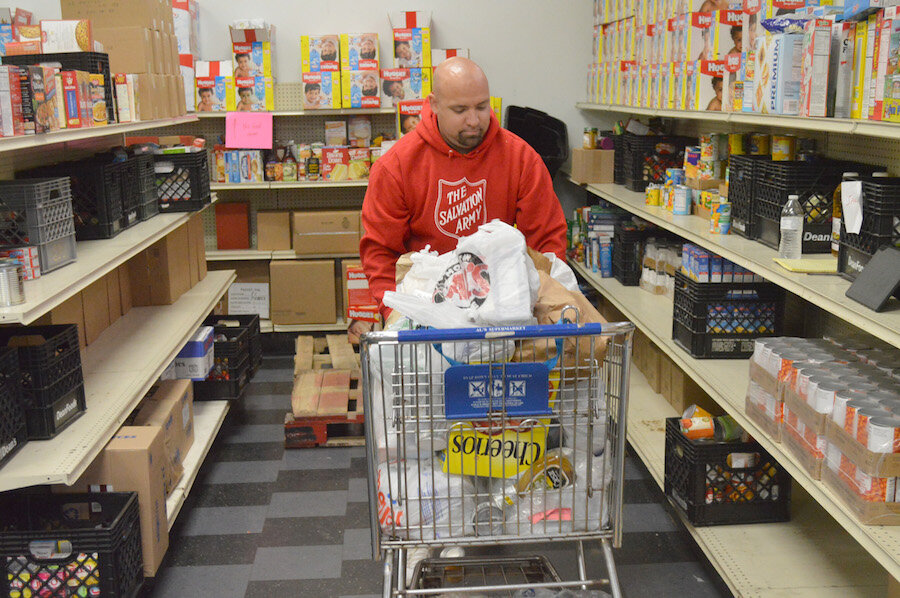Charitable giving sets new record, but why are religious donations waning?
Loading...
It took seven years, but charitable giving in the US finally has set a new record. However, organizations that historically have accounted the bulk of such donations – churches – are losing ground as congregations shrink and givers embrace a wider variety of charitable causes.
American donors were more generous than ever in 2014, giving an estimated $358.4 billion to charity, according to an annual report released Tuesday by the Giving USA Foundation, a Chicago-area nonprofit. The 2014 total is 7.1 percent higher than 2013, and the highest total since the previous annual record set in 2007 (an estimated 355.17 billion) before the Great Recession.
Contributions rose in 8 of 9 charity categories, with only donations to international affairs declining. But the composition of those donations is changing; In particular, religious giving has been ceding ground to other categories over the past few decades, and that trend continued in 2014.
When adjusted for inflation, donations to religious organizations grew just 0.9 percent year-over year – the smallest increase among all categories.
"While the overall growth is indicative of robust philanthropy … we would be remiss to gloss over what is happening with giving to religion,” Giving USA chairman David King said in the report’s release. Religion still accounts for the largest percentage of donations, and along with six other categories, it reached a new peak in 2014 with $114.9 billion in contributions. But religious giving “is continuing its 30-year dramatic downward slide,” Mr. King notes. “In fact, it has dropped from 53 percent of all donations in 1987 to 32 percent of the total in 2014.”
Unsurprisingly, demographics have a lot to do with religion’s shrinking piece of the charity pie. According to a recent Pew study, the number of Americans who don’t have any religious affiliation grew to about 56 million last year, a nearly 7 percent increase just since 2007. Over the same period, the share of Americans who identify as Christians, while still a vast majority, has dropped from about 78 percent of the US population in 2007 to 71 percent in 2014. The trend is even more pronounced among Millennial adults; those with no religious affiliation outnumber both mainline Protestants and Catholics in that age group.
“When we look at the religious sector, [donations] come primarily from houses of worship,” says Giving USA Foundation chairman and nonprofit consultant Keith Curtis, in a phone interview. “When people are not attending, that means they’re not giving.”
But shifts in the giving landscape itself also play a big role. For one, certain religious-oriented charitable organizations that do other types of work, like Salvation Army and Catholic Relief Services, aren’t counted as part of the ‘religion’ umbrella, but under categories like human services and international affairs, which have grown at a faster clip.
Second, as the wealthiest Americans grow even wealthier, large, individual gifts make up a growing proportion of charitable gifts. Giving USA’s report noted several gifts over $200 million over the past year, and one over $2 billion. Those gifts, Mr. Curtis notes, “have a tendency to go to education, arts and culture, health.”
Indeed, the arts, culture, and humanities category saw the biggest year-over-year increase among categories, climbing 7.4 percent when adjusted for inflation.
Religious gifts, on the other hand, tend to come from a wider cross-section of donors, including people who are still cautious about their finances. “Collection plate” donations tend to be more tied to individual income, he notes, while bigger gifts tend to be tied to assets and wealth (the latter has ballooned since the recession; the former, not so much).
Churches are trying to break out of that week-to-week rut by reaching out to donors online, holding annual pledges, and even introducing tithing via text message. And churchgoers are by no means tightening their purse strings. On the contrary, a 2013 study found that religious Americans are more likely to give than their nonreligious counterparts. It’s just that they are giving beyond the collection plate. “Americans want to help people in need and organizations that make a difference, and they may only have a certain amount of money to give to all of their causes,” Curtis says.








